Wearable Piezoelectric-Based System for Continuous Beat-to-Beat Blood Pressure Measurement
Abstract
:1. Introduction
2. Measurement Strategy
- Step 1:
- The initial blood pressure is measured by the cuff method.
- Step 2:
- The pressure signals from the radial artery are converted to an electrical signal through the piezoelectric sensor. Continuous PPW signals are filtered and amplified by the front-end analog circuit
- Step 3:
- The voltage change of SBP and DBP feature points is identified within the adjacent PPW signals (Figure 1a).
- Step 4:
- The voltage change (ΔmV) of SBP and DBP feature points are converted to pressure change (ΔmmHg) of SBP and DBP by the pressure sensitivity of the piezoelectric sensor (Figure 1b).
- Step 5:
- Sum of initial blood pressure by cuff method and pressure changes by the piezoelectric sensor to achieve beat-to-beat SBP and DBP monitoring, according to Equations (2) and (3) (Figure 2)
3. System Design
3.1. Piezoelectric Sensor
3.2. Front-End Analog Circuit
3.3. Post-Processing Unit
3.4. Ethics Statement
4. Experimental results
4.1. Pressure Pulse Wave (PPW) Signals Analysis for Beat-to-Beat Systolic Blood Pressure (SBP) and Diastolic Blood Pressure (DBP)
4.2. Continuous Blood Pressure Measurement and Accuracy Evaluation
5. Discussions
5.1. Measurement Strategy and Performance
5.2. Accuracy Evaluation with Other Works
5.3. Limitation
6. Conclusions
Author Contributions
Funding
Conflicts of Interest
References
- Kitterman, J.A.; Phibbs, R.H.; Tooley, W.H. Catheterization of umbilical vessels in newborn infants. Pediatr. Clin. N. Am. 1970, 17, 895–912. [Google Scholar] [CrossRef]
- Chen, S.; Ji, Z.; Wu, H.; Xu, Y. A Non-Invasive Continuous Blood Pressure Estimation Approach Based on Machine Learning. Sensors 2019, 19, 2585. [Google Scholar] [CrossRef] [PubMed] [Green Version]
- Goli, S.; Jayanthi, T. Cuff less continuous non-invasive blood pressure measurement using pulse transit time measurement. Int. J. Recent Dev. Eng. Technol. 2014, 2, 16–86. [Google Scholar]
- Choi, Y.; Zhang, Q.; Ko, S. Noninvasive cuffless blood pressure estimation using pulse transit time and Hilbert–Huang transform. Comput. Electr. Eng. 2013, 39, 103–111. [Google Scholar] [CrossRef]
- Nye, E. The effect of blood pressure alteration on the pulse wave velocity. Br. Heart J. 1964, 26, 261. [Google Scholar] [CrossRef] [Green Version]
- Gribbin, B.; Steptoe, A.; Sleight, P. Pulse wave velocity as a measure of blood pressure change. Psychophysiology 1976, 13, 86–90. [Google Scholar] [CrossRef]
- Chen, W.; Kobayashi, T.; Ichikawa, S.; Takeuchi, Y.; Togawa, T. Continuous estimation of systolic blood pressure using the pulse arrival time and intermittent calibration. Med. Biol. Eng. Comput. 2000, 38, 569–574. [Google Scholar] [CrossRef]
- Peter, L.; Noury, N.; Cerny, M. A review of methods for non-invasive and continuous blood pressure monitoring: Pulse transit time method is promising? Irbm 2014, 35, 271–282. [Google Scholar] [CrossRef]
- Lazazzera, R.; Belhaj, Y.; Carrault, G. A New Wearable Device for Blood Pressure Estimation Using Photoplethysmogram. Sensors 2019, 19, 2557. [Google Scholar] [CrossRef] [Green Version]
- Slapničar, G.; Mlakar, N.; Luštrek, M. Blood Pressure Estimation from Photoplethysmogram Using a Spectro-Temporal Deep Neural Network. Sensors 2019, 19, 3420. [Google Scholar] [CrossRef] [Green Version]
- Sharma, M.; Barbosa, K.; Ho, V.; Griggs, D.; Ghirmai, T.; Krishnan, S.; Hsiai, T.; Chiao, J.-C.; Cao, H. Cuff-less and continuous blood pressure monitoring: A methodological review. Technologies 2017, 5, 21. [Google Scholar] [CrossRef] [Green Version]
- Proença, J.; Muehlsteff, J.; Aubert, X.; Carvalho, P. Is pulse transit time a good indicator of blood pressure changes during short physical exercise in a young population? In Proceedings of the International Conference of the IEEE Engineering in Medicine and Biology Society, Buenos Aires, Argentina, 31 August–4 September 2010. [Google Scholar]
- Wong, M.Y.-M.; Poon, C.C.-Y.; Zhang, Y.-T. An evaluation of the cuffless blood pressure estimation based on pulse transit time technique: A half year study on normotensive subjects. Cardiovasc. Eng. 2009, 9, 32–38. [Google Scholar] [CrossRef] [PubMed]
- Fung, P.; Dumont, G.; Ries, C.; Mott, C.; Ansermino, M. Continuous noninvasive blood pressure measurement by pulse transit time. In Proceedings of the International Conference of the IEEE Engineering in Medicine and Biology Society, San Francisco, CA, USA, 1–5 September 2004. [Google Scholar]
- Mase, M.; Mattei, W.; Cucino, R.; Faes, L.; Nollo, G. Feasibility of cuff-free measurement of systolic and diastolic arterial blood pressure. J. Electrocarsiol. 2011, 44, 201–207. [Google Scholar] [CrossRef] [PubMed]
- Kim, J.; Chou, E.F.; Le, J.; Wong, S.; Chu, M.; Khine, M. Soft Wearable Pressure Sensors for Beat-to-Beat Blood Pressure Monitoring. Adv. Healthc. Mater. 2019, 8, 1900109. [Google Scholar] [CrossRef] [PubMed]
- Liu, Z.-D.; Liu, J.-K.; Wen, B.; He, Q.-Y.; Li, Y.; Miao, F. Cuffless Blood Pressure Estimation Using Pressure Pulse Wave Signals. Sensors 2018, 18, 4227. [Google Scholar] [CrossRef] [Green Version]
- Kaisti, M.; Panula, T.; Leppänen, J.; Punkkinen, R.; Tadi, M.J.; Vasankari, T.; Jaakkola, S.; Kiviniemi, T.; Airaksinen, J.; Kostiainen, P. Clinical assessment of a non-invasive wearable MEMS pressure sensor array for monitoring of arterial pulse waveform, heart rate and detection of atrial fibrillation. NPJ Digit. Med. 2019, 2, 39. [Google Scholar] [CrossRef] [Green Version]
- Spinelli, E.M.; Pallàs-Areny, R.; Mayosky, M.A. AC-coupled front-end for biopotential measurements. IEEE T. Bio Med. Eng. 2003, 50, 391–395. [Google Scholar] [CrossRef] [Green Version]
- Çakar, H.İ.; Kara, S.; Toker, O. Design of a Portable Electromyography Device for Back Herniated Patients. In Proceedings of the International Conference on Biomedical Electronics and Devices, Valencia, Spain, 20–23 January 2010. [Google Scholar]
- White, W.B.; Berson, A.S.; Robbins, C.; Jamieson, M.J.; Prisant, L.M.; Roccella, E.; Sheps, S.G. National standard for measurement of resting and ambulatory blood pressures with automated sphygmomanometers. Hypertension 1993, 21, 504–509. [Google Scholar] [CrossRef] [Green Version]
- O’Brien, E.; Petrie, J.; Littler, W.; de Swiet, M.; Padfield, P.L.; Altman, D.; Bland, M.; Coats, A.; Atkins, N. The British Hypertension Society protocol for the evaluation of blood pressure measuring devices. J. Hypertens 1993, 11, S43–S62. [Google Scholar]
- Simjanoska, M.; Gjoreski, M.; Gams, M.; Madevska Bogdanova, A. Non-invasive blood pressure estimation from ECG using machine learning techniques. Sensors 2018, 18, 1160. [Google Scholar] [CrossRef] [Green Version]
- Wang, Y.-J.; Chen, C.-H.; Sue, C.-Y.; Lu, W.-H.; Chiou, Y.-H. Estimation of Blood Pressure in the Radial Artery Using Strain-Based Pulse Wave and Photoplethysmography Sensors. Micromachines 2018, 9, 556. [Google Scholar] [CrossRef] [PubMed] [Green Version]
- Liu, S.-H.; Cheng, D.-C.; Su, C.-H. A cuffless blood pressure measurement based on the impedance plethysmography technique. Sensors 2017, 17, 1176. [Google Scholar] [CrossRef] [PubMed] [Green Version]
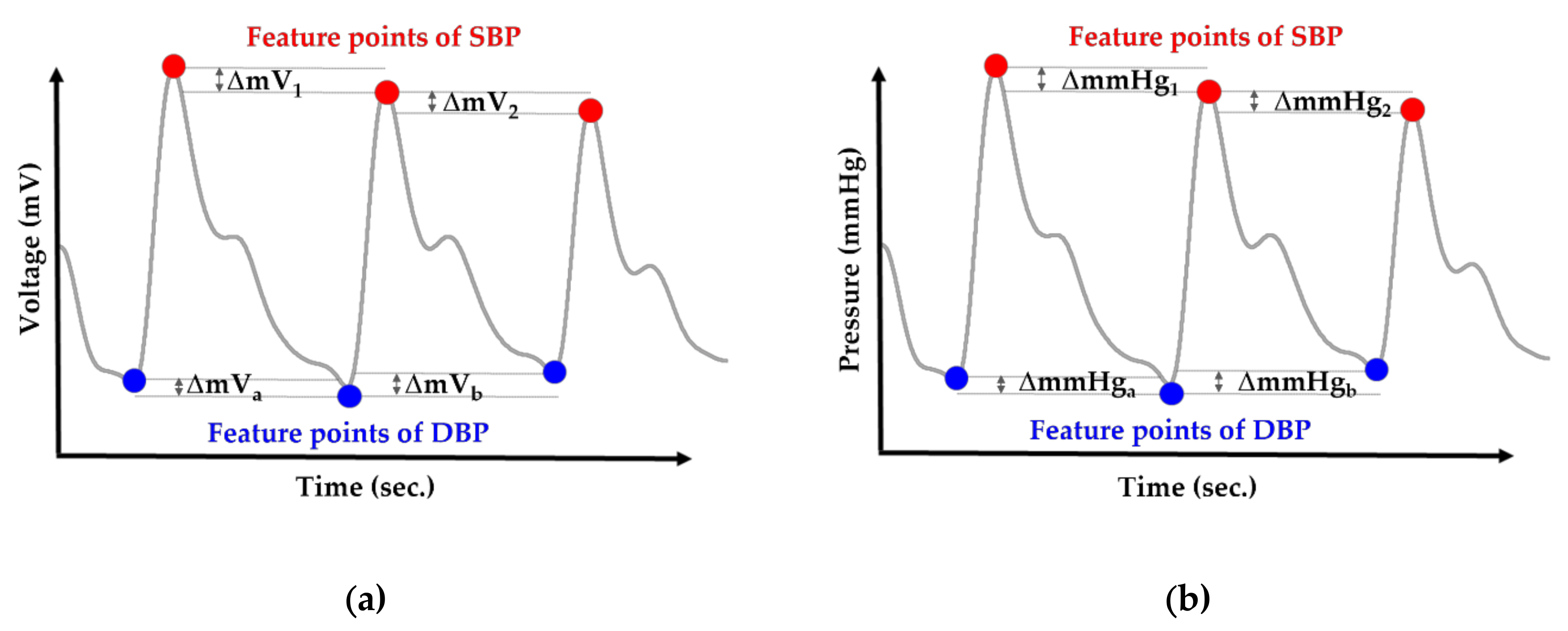
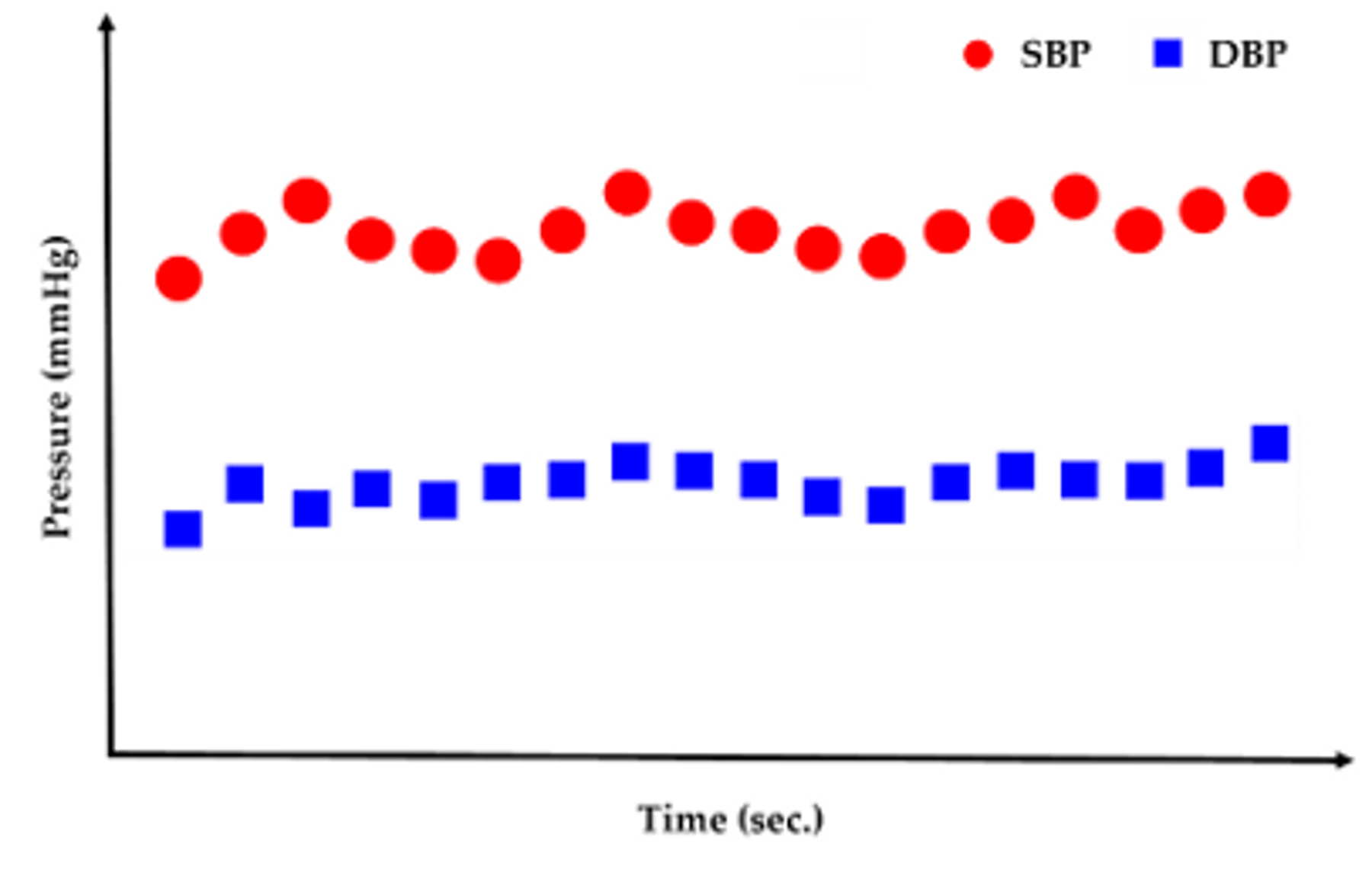
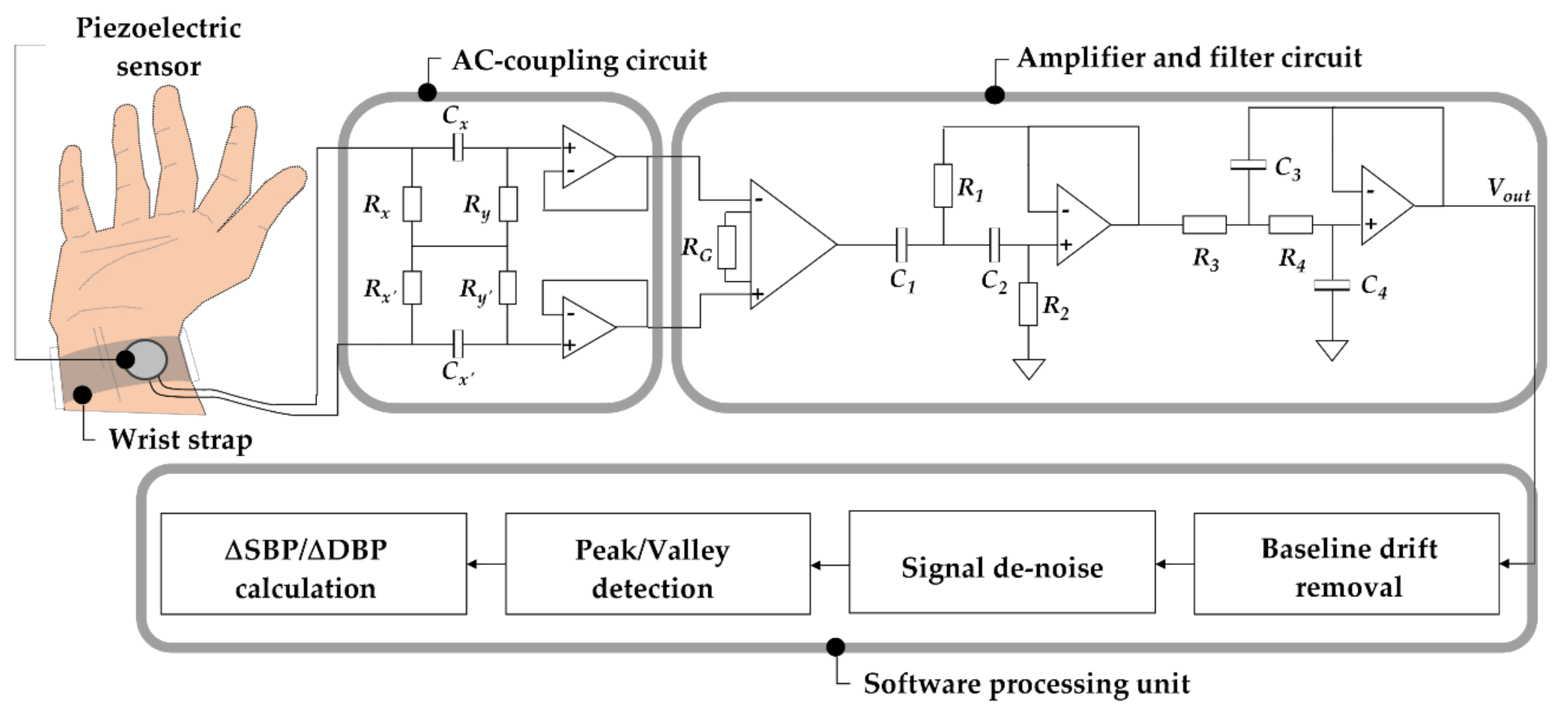
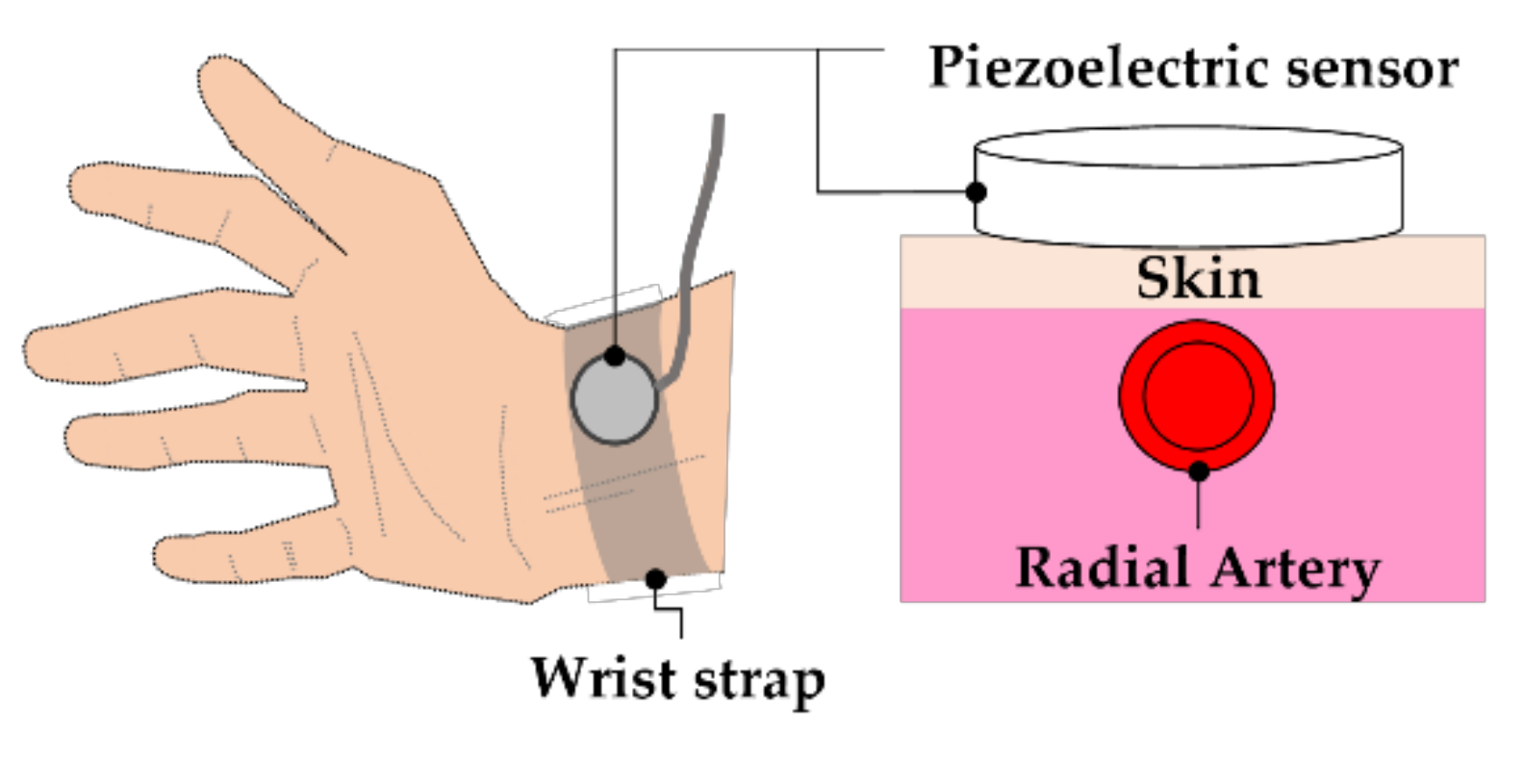
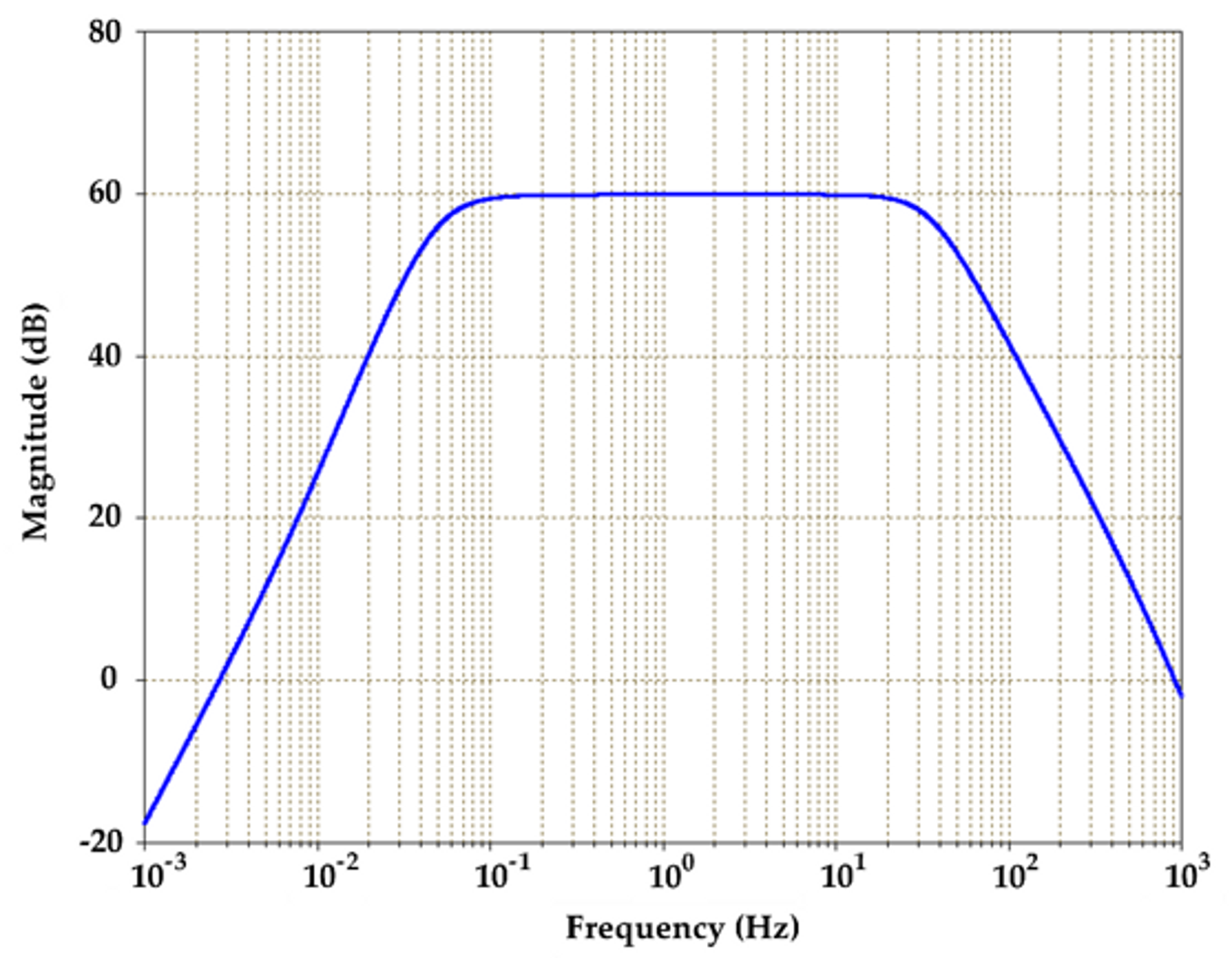





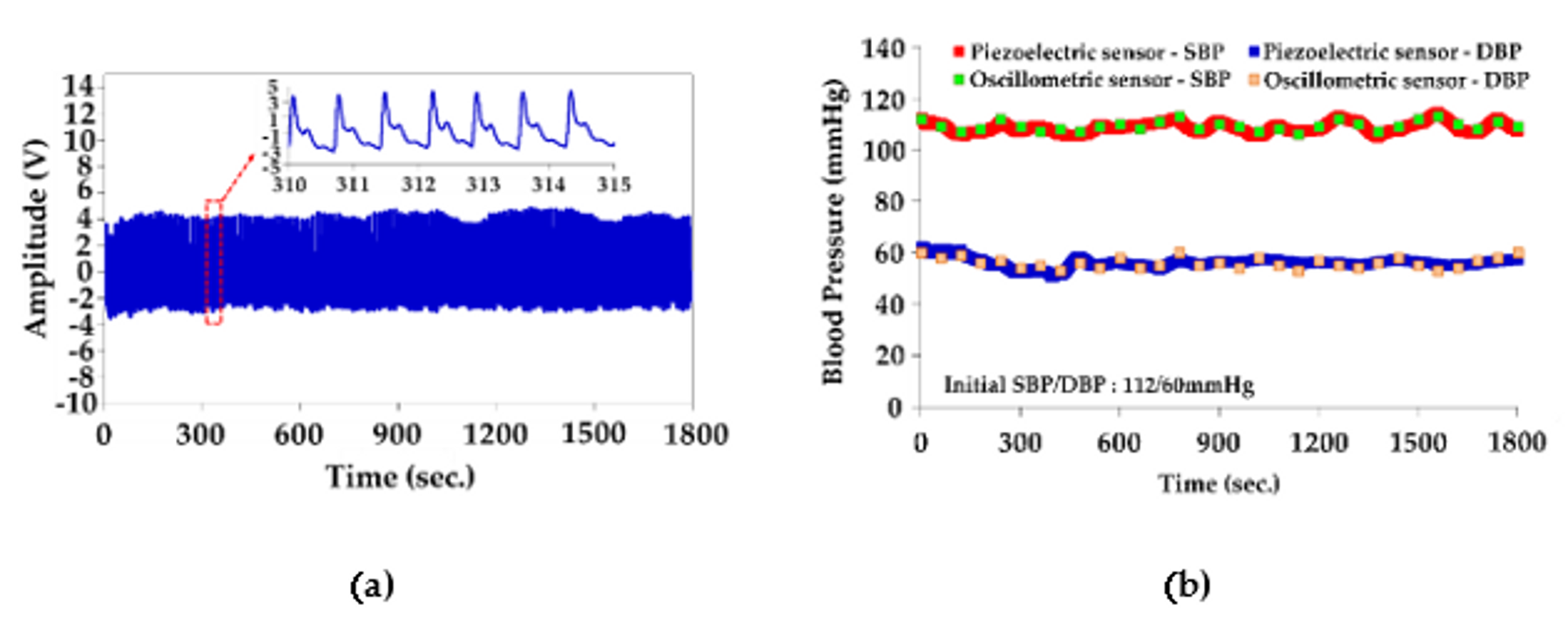
| Subject | Male | Age | Height (cm) | Weight (kg) | SBP Error (MAE ± SD mmHg) | DBP Error (MAE ± SD mmHg) |
|---|---|---|---|---|---|---|
| 1 | Male | 58 | 180 | 90 | 1.34 ± 0.07 | 1.61 ± 0.16 |
| 2 | Female | 57 | 150 | 68 | 1.51 ± 0.13 | 1.92 ± 0.22 |
| 3 | Male | 60 | 170 | 80 | 1.46 ± 0.17 | 1.87 ± 0.29 |
| 4 | Female | 36 | 155 | 66 | 1.62 ± 0.21 | 2.01 ± 0.38 |
| 5 | Male | 31 | 168 | 65 | 1.24 ± 0.27 | 1.56 ± 0.39 |
| 6 | Male | 36 | 175 | 90 | 1.44 ± 0.33 | 1.64 ± 0.66 |
| 7 | Male | 27 | 175 | 68 | 1.47 ± 0.22 | 1.77 ± 0.52 |
| 8 | Female | 27 | 156 | 55 | 1.7 ± 0.42 | 2.06 ± 0.71 |
| 9 | Female | 24 | 160 | 90 | 1.39 ± 0.35 | 1.72 ± 0.66 |
| 10 | Male | 28 | 180 | 110 | 1.58 ± 0.44 | 1.95 ± 0.77 |
| 11 | Male | 36 | 176 | 105 | 1.22 ± 0.21 | 1.84 ± 0.51 |
| 12 | Female | 27 | 163 | 55 | 1.38 ± 0.19 | 1.79 ± 0.44 |
| 13 | Female | 27 | 164 | 61 | 1.66 ± 0.47 | 1.68 ± 0.41 |
| 14 | Male | 27 | 168 | 68 | 1.53 ± 0.38 | 1.72 ± 0.49 |
| 15 | Male | 27 | 165 | 79 | 1.47 ± 0.24 | 1.76 ± 0.39 |
| 16 | Male | 27 | 168 | 72 | 1.51 ± 0.26 | 1.89 ± 0.44 |
| 17 | Male | 27 | 170 | 68 | 1.42 ± 0.33 | 1.77 ± 0.46 |
| 18 | Female | 59 | 156 | 71 | 1.45 ± 0.22 | 1.87 ± 0.34 |
| 19 | Female | 54 | 154 | 50 | 1.38 ± 0.28 | 1.92 ± 0.44 |
| 20 | Male | 23 | 168 | 66 | 1.54 ± 0.36 | 1.86 ± 0.55 |
| 21 | Male | 27 | 163 | 62 | 1.58 ± 0.32 | 1.83 ± 0.51 |
| 22 | Male | 23 | 178 | 72 | 1.56 ± 0.28 | 1.78 ± 0.61 |
| 23 | Male | 20 | 173 | 68 | 1.33 ± 0.15 | 1.82 ± 0.53 |
| 24 | Female | 21 | 160 | 58 | 1.49 ± 0.24 | 1.79 ± 0.46 |
| 25 | Female | 27 | 160 | 54 | 1.62 ± 0.33 | 1.96 ± 0.61 |
| 26 | Male | 20 | 175 | 53 | 1.84 ± 0.37 | 1.77 ± 0.55 |
| 27 | Male | 20 | 174 | 105 | 1.58 ± 0.41 | 2.07 ± 0.66 |
| 28 | Male | 23 | 183 | 71 | 1.77 ± 0.55 | 1.88 ± 0.73 |
| 29 | Male | 20 | 170 | 85 | 1.67 ± 0.41 | 1.83 ± 0.55 |
| 30 | Female | 20 | 155 | 61 | 1.89 ± 0.43 | 1.88 ± 0.62 |
| Average | 1.52 ± 0.30 | 1.83 ± 0.50 |
| Author | Technique | Statistic Method | SBP Error (mmHg) | DBP Error (mmHg) | Ref. |
|---|---|---|---|---|---|
| Lazazzera | MAE ± SD | 1.52 ± 9.45 | 0.39 ± 4.93 | [9] | |
| Simjanoska | MAE ± SD | 7.72 ± 10.22 | 9.45 ± 10.03 | [23] | |
| Slapniˇcar | MAE | 9.43 | 6.88 | [10] | |
| Wang | MAE ± SD | 3.71 ± 3.06 | 5.44 ± 5.10 | [24] | |
| Liu | Correlation coefficient | 0.7 | - | [25] | |
| Liu | MAE ± SD | 0.70 ± 7.78 | 0.83 ± 5.43 | [17] | |
| Our work | MAE ± SD | 1.52 ± 0.30 | 1.83 ± 0.50 | - |
© 2020 by the authors. Licensee MDPI, Basel, Switzerland. This article is an open access article distributed under the terms and conditions of the Creative Commons Attribution (CC BY) license (http://creativecommons.org/licenses/by/4.0/).
Share and Cite
Wang, T.-W.; Lin, S.-F. Wearable Piezoelectric-Based System for Continuous Beat-to-Beat Blood Pressure Measurement. Sensors 2020, 20, 851. https://doi.org/10.3390/s20030851
Wang T-W, Lin S-F. Wearable Piezoelectric-Based System for Continuous Beat-to-Beat Blood Pressure Measurement. Sensors. 2020; 20(3):851. https://doi.org/10.3390/s20030851
Chicago/Turabian StyleWang, Ting-Wei, and Shien-Fong Lin. 2020. "Wearable Piezoelectric-Based System for Continuous Beat-to-Beat Blood Pressure Measurement" Sensors 20, no. 3: 851. https://doi.org/10.3390/s20030851
APA StyleWang, T.-W., & Lin, S.-F. (2020). Wearable Piezoelectric-Based System for Continuous Beat-to-Beat Blood Pressure Measurement. Sensors, 20(3), 851. https://doi.org/10.3390/s20030851






